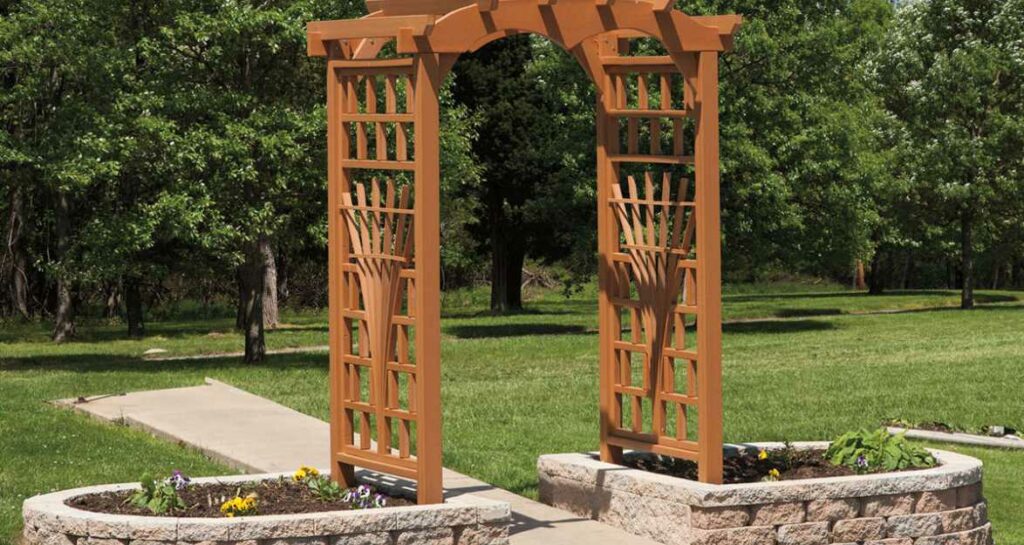

Garden Arbors
What’s an arbor?
It’s like Alice’s door to an outdoor wonderland! An arbor is an outdoor archway used in various ways to accent and beautify outdoor garden and landscape spaces. Arbors often double as a structure featuring crosshatched slats or other designs on its sides and top for vining or climbing plants to grow over, around, and through. Arbors are available in lots of styles and widths and may be constructed from various materials.
Choose just the right arbor for you to create delightful outdoor spaces with the perfect function and mood!
Our Simple Process Makes it So Easy to Work With Us!

Share your vision
We want to understand your dream and then personalize a solution to match your vision.

Let's Collaborate
Once you are happy and approve our proposal, we are ready to get to work!

We'll build it
We will choose the best way to create your structure. Relax and enjoy your dream come true.
Frequently Asked Questions about Garden Arbors
Garden arbors have a rich history of bringing beauty and shade to the outdoor space. These attractive arches are often used as focal points in garden design, designating entrances or creating seating nooks and shade tunnels over or along garden paths. Relax with your significant other on an arbor seat at the fragrant ending of an enchanted rose garden pathway. Lose yourself in a novel with the gentle rhythm of an arbor swing beneath the cascading foliage and blossoms of a Mandevilla or honeysuckle vine. Exchange marriage vows under the breathless beauty of a wedding arbor bursting with summer blossoms. Create a stately entrance to your garden path with a gate arbor. The possibilities are endless!
Any plant that climbs or has a vine is a great candidate for your arbor. Quick-growing foliage vines such as ivy will interweave the arbor, becoming a living arch embedded in the planting landscape. Hundreds of flowering vines, such as morning glory, clematis, and vining roses, are candidates for your garden arbor or wedding arbor for a showy arch of delightful blossoms. Slower growing fruiting or blossoming trees can also grace an arbor and grow to be a majestic structure if patiently trained along the arbor over time. Growing vine fruits such as grapes, blackberries, and others is especially rewarding. The arbor provides excellent support for easy picking, and the vines and foliage provide beauty and shade for an arbor seat or wayside arbor in the non-fruiting seasons.
A pergola is also an outdoor landscape structure, so what’s the difference between an arbor and a pergola? In short, it’s function and size. Pergolas often span a patio or porch area to provide an overhead structure of beauty and some shade. Pergolas are sometimes a host to shade plants but often remain a standalone design element in landscape architecture. On the other hand, arbors are smaller and often host climbing plants for use as an archway, garden arbor seat, or garden arbor swing. Arbors can be fitted with doors or gates or installed as a stand-alone structure to serve as a handsome focal point to the entrance of a garden path or backyard space. You can match the arbor’s style and construction materials to other garden structures, including pergolas, for a particularly stunning effect.
Great question! The answer depends on the effect you want. Many folks love arbors for the accenting arches to the entrances or exits of an outdoor area. Matching arbors at each of the entrances to a garden, backyard or landscape, creates a majestic mood and gives prominence to the value of the space. Place an arbor seat or an arbor swing along the pathway for a tranquil retreat for your morning coffee or unwinding after work. Garden arbors are a picturesque destination at the end of a meandering landscape pathway. A garden arbor with a gate will be the perfect complement to a quaint, enchanting flower garden or a stunning landscape.
There are several ways you can secure your new arbor to the ground, from lightweight to ultra-permanent. But rest assured, any of the options are easy for the average consumer to complete if the steps are followed carefully.
- On the lightweight side, you can drive treated lumber or metal stakes into the ground at each leg of the arbor (minimum of 2 feet deep) with the top of the stake below the final grade surface. The arbor legs can then be screwed or bolted to the stake.
- Midweight installation methods use a 24” screw anchor twisted into the ground at each arbor leg a few inches subsurface, with each leg bolted to the screw anchor.
- You can obtain a more permanent installation by digging a 6” diameter hole with a post-hole digger below the frost line for your area. Fill it to a few inches below surface level with a bag concrete mix, and plant a pipe or post in each concrete pad that will extend up into each leg of the arbor. Once the concrete is set up, slip the arbor legs down over the posts. Drill into the leg at a sub-surface level and bolt it to the posts. Use permanent installation methods for swing arbors, seat arbors, gate arbors, or any substantial structure susceptible to wind or other lateral forces.
Great news! Arbors add an amazing sense of value to outdoor spaces and bring an atmosphere of substance and luxury at a surprisingly low cost. Modern Arbors have become extremely popular in residential and commercial areas because of the dramatic enhancement and broad styling options they make for minimal investment. Any gardener, landscape improver, or event planner can transform their space on a modest budget, with tastes ranging from country cottage to English formal. Outdoor Personia’s arbors come in a variety of options, from the economical to the elaborate. Wood arbors, vinyl arbors, and composite material arbors are all options we offer. Other things that affect the price are the styling type, the dimensions, and extra features like an arbor seat or arbor swing. See the pricing listed with each arbor option. There is an arbor for every occasion and application
The height of your garden arbor is a matter of personal preference or what best fits the purpose of the arbor and how it looks best in the setting. Swing arbors should be 8 feet or higher for the best swing experience. Wedding Arbors should be at a height that looks proportionate to the length, and that will comfortably provide an outdoor ceiling for the bride, groom, and wedding party, without feeling low or closed-in. Arbors adorning the entrance of gardens or pathways should be a minimum of 7.5 feet for a tall person to walk through comfortably without ducking, yet not too high, to preserve the cozy archway effect.
Outdoor Personia brings you a wide variety of arbors in various weights, widths, styles, and colors. We have wooden arbors, poly arbors, and arbors made of composite materials. Join thousands of Americans who have discovered the inexpensive yet dramatic makeovers these delightful little arches bring to outdoor spaces, gardens, pathways, bridal destinations, and landscapes.
Drop by either other of our design centers in Bellingham or Hanover to choose the perfect fit for you.
